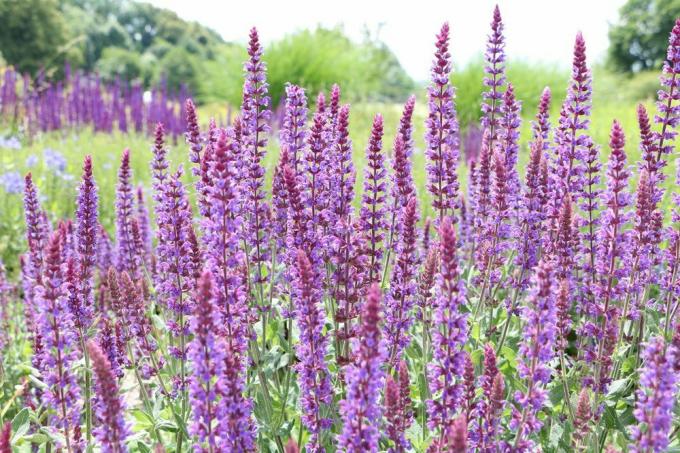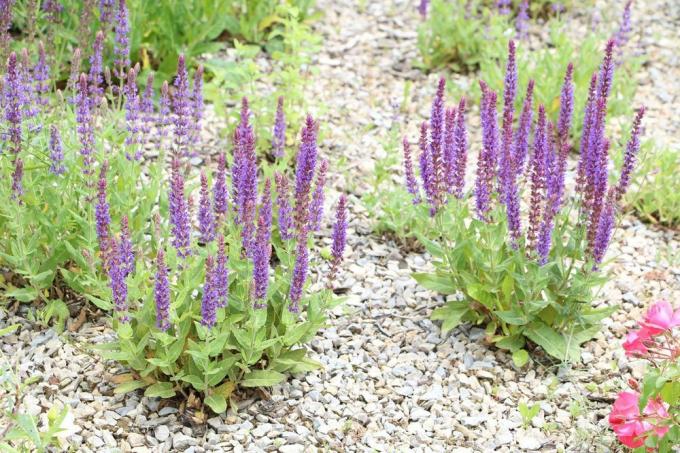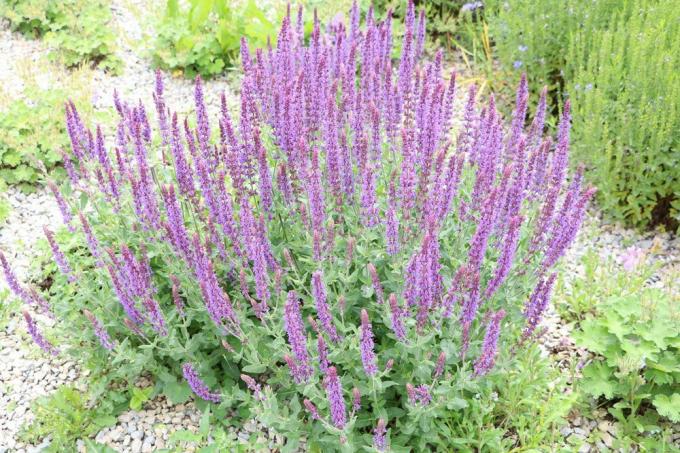
table of contents
- care
- Location
- floor
- to water
- Fertilize
- plants
- Cut
- Multiply
- Popular varieties
Profile and care information open +conclude -
- Flower color
- purple, blue
- Location
- Sunny, full sun
- Heyday
- June, July, August, September
- Growth habit
- upright, bushy, clump-forming, perennial
- height
- up to 70 centimeters high
- Soil type
- sandy, loamy, gritty
- Soil moisture
- moderately dry, fresh
- PH value
- alkaline
- Limescale tolerance
- Calcium tolerant
- humus
- k. A.
- Poisonous
- no
- Plant families
- Mint family, Lamiaceae
- Plant species
- Perennials, ornamental plants
- Garden style
- Flower garden, cottage garden, ornamental garden
The decorative sage impresses in gardens and on open spaces with its color intensity. The botanical name is Salvia nemorosa. The ornamental sage, also steppe sage or grove sage, has flowers in long spikes in shades of purple and blue. The height of the different species of Salvia nemorosa fluctuates. Some varieties grow up to 70 centimeters high. Other varieties only reach about 40 centimeters. The flowering time of the ornamental sage extends from the first days in June to September.
care
With its beautiful flowers, the plant magically attracts insects. That is why it has a good reputation as a bee pasture. Butterflies and bumblebees also like the nectar of the deep-colored flowers of Salvia nemorosa. The colors and shapes in which the spike-shaped flowers ennoble their surroundings depend on the type of steppe sage.

Location
Grove sage is a child of the sun. All types of ornamental sage like very bright locations in the garden. The plant is not affected by full sun. The perennial feels very comfortable in all warm places in the garden. Grove sage is fond set in groups with other plants. Perennials in the neighborhood should be planted so that they do not compete with the steppe sage for light. The lighter Salvia nemorosa is and the more sun it gets, the more splendidly it blooms.
- Light: full sun or as very bright as possible
- Temperatures: warm
- Wind: sheltered from the wind
- Environment: rather dry
floor
Demands on the soil
Garden sage makes little demands on the garden soil. It thrives on almost any soil if it is loose and not too heavy. Garden soils that are quite dry and well permeable to moisture are ideal. Heavy and loamy soils must be loosened before planting. To do this, the gardener mixes sand and humus into the earth. This makes it more permeable to water and no longer accumulates moisture.
Salvia nemorosa does not respond well to waterlogging. Low to medium-high growing varieties of grove sage also thrive in pots and tubs. When planting in pots, however, drainage should be created to protect the sensitive roots from waterlogging.

The ideal soil for Salvia nemorosa:
- sandy, loose
- well permeable to moisture
- may also be dry
- airy
- nutrient-rich, humic
- Bucket: potting soil enriched with sand and gravel
to water
Do not pour in excess
The water requirement of the ornamental sage is medium to low. This is why the plant is also extremely suitable for dry areas in garden zones. The greatest enemy of Salvia nemorosa is waterlogging, as it occurs especially in soils that are too heavy. Regular administration of water is only necessary during the flowering period from July to September.
Even then, the plant does not have to be watered excessively. Watering water is carefully poured into the lower part of the plant, but best applied directly to the garden soil. The flowers and leaves of the perennial are sensitive and should not come into direct contact with a jet of water.
Fertilize
Reluctance to fertilize
The grove sage hardly needs excessive nutrition. If the soil around the roots is humus and full, the plant can manage with just two fertilizers per year. The perennial receives its first fertilization in early spring and therefore in time for new growth. A second fertilization is recommended for the steppe sage immediately after the first flowering at the end of July. It provides the plant with enough nutrients so that it can produce a late bloom in September.

plants
Plants at the right time
It is best to plant the perennials in spring. Anyone who decides not to put new plants in the ground until autumn must definitely do so before the first frost. Before you can plant the new perennials in the ground, you should be clear again about the high demand of sage for air, light and sun. The correct spacing between the individual plants is selected accordingly.
Because when the perennial sprouts, it needs space. Only then does it really come into its own. The ideal distance between the plants is between 30 and 50 centimeters, depending on the variety. Before planting, the root ball is immersed in water for a long time so that it swells well. The perennial is set in the ground in such a way that the upper edge of the root ball is flush with the surface of the soil.
Cut
Cut ornamental sage with care
Steppe sage shares the peculiarity of many native perennials in the ornamental garden. They have the ability to produce another second bloom after a first bloom. This places special demands on the gardener when it comes to cutting. Because the cut has to be done carefully and deliberately. The second bloom in early autumn usually only develops when the steppe sage is cut back close to the ground, immediately after the first bloom.
Such a cut is not absolutely necessary for the care and maintenance of the plant. The ornamental sage thrives magnificently even without this powerful pruning. However, the ornamental sage usually does not form a second flower without the early pruning.

Promote new growth with re-cutting
However, a few varieties of ornamental sage are totally grateful for a rigorous pruning after their first flowering is complete. In this so-called remounting cut, the entire perennial is trimmed to between five to ten centimeters above the garden soil. Dried or even diseased leaves are also completely removed.
The plant then begins to sprout again. To support it, the ornamental sage should be fertilized after a re-cut and watered regularly in the first few weeks. Species of the ornamental sage bloom in June and July and then again in September after the rigorous pruning. However, this second bloom is not quite as abundant.
Remounting cut:
- promotes strong, healthy new growth of the plant
- ensures safe re-flowering
- Self-sowing is prevented
Cut out flowers
If the right time for re-cutting was missed, the withered inflorescences should still be cut out. This is also recommended if the ornamental sage is to be kept bushy over the summer. Cutting off withered flowers makes for a better look. In addition, the gardener prevents the steppe sage from spreading across the garden by itself without control by sowing.
Remove seed heads
By removing the seed heads, the gardener ensures that the plants are varietal. If the offspring of plants arise without control by self-sowing from the mother plant, then these are usually hardly similar. They differ not only in the shape and color of the flowers, but mostly also in other properties. So before the seeds dry out and spread through sowing, they should be cut off.
Cut after winter
A strong pruning of the garden sage is indicated before the plant sprouts in spring. This radical cut can alternatively be made in late autumn. However, the later pruning protects the perennial much better against damage from frost. The cut is made a hand's breadth above the ground. Be careful not to cut into the old wood. The steppe sage does not tolerate frost damage. It is cut to about a hand's breadth above the ground, but not particularly well.
- Cut: right after the first bloom
- Alternatively: cut back quite heavily in late autumn
- Approach: about one hand above the garden soil
- Caution: do not cut into the old and lignified shoots
Winter protection
Most varieties of steppe sage are hardy. They tolerate temperatures down to minus 25 degrees. A little protection from the dry and cold in snow-free areas and from excessive moisture is nevertheless advisable. Covered with brushwood, straw or dry leaves, the plants get through the winter well. The material should only be piled up in a very thin layer. A thicker cover leads to fungal infestation and the multiplication of pests in mild weather and humidity.

Not all types of ornamental sage can be left outdoors in winter. Some varieties are not hardy. If the grove sage is to be in a border or a bed, winter-hardy specimens should be used when buying. If the plants are not hardy, they can be better planted in tubs or pots. Then a sheltered winter in a cold house is possible. Non-winter-hardy varieties must not remain in the bed, they are dug up and brought frost-free through the cold season.
Multiply
Propagate steppe sage
The steppe sage can be propagated in very different ways. The individual varieties can be sown. Propagation is also easily possible with cuttings, just like by dividing the plant.
It is possible to sow the grove sage as early as March on the windowsill in a warm room. When a few leaves show up, the young plants are separated into pots. From mid-May, the then somewhat stronger plants migrate to the field.
Cuttings for new plants are cut from the perennials that already exist in the garden. Propagation by cuttings is particularly worthwhile for annual varieties. In summer you cut shoots about 15 centimeters long. They have to be unlignified. In moist soil, the cuttings form roots in a warm and bright place until autumn. Then they can be planted out when the variety is hardy. If the species is sensitive to the cold, the cuttings must be overwintered in a light and, above all, frost-free. They do not come into the bed until May.
Rejuvenate and divide plants
Garden sage, too, gets old and aged after a few years. This is what the plant has in common with the majority of perennials. In the bed, the plant then only forms a few new shoots and hardly develops any flowers. A good method to rejuvenate the perennial and thereby increase it is division.
Share step by step:
- Time: early autumn
- Dig up: carefully, do not damage the roots, knock off the earth
- Root ball: pull apart carefully
- Edge area: remove fist-sized pieces here
- Separating: with a sharp knife or a spade
Only clean equipment should be used for cutting when dividing. The cut surface should be kept as small as possible so that there is little contact surface for possible damage and the transmission of diseases. Make the cuts smooth. The perennials are then replanted with fresh soil. Regular watering is indicated in the first few weeks.

Popular varieties
Popular species with beautiful colors
- Marcus: deep purple flowers in panicles
- Amethyst: pink-purple lip-flowers and stems in purple
- Blue hill: intense blue flowers, spike-shaped
- Threshold castle: reddish to pink-colored high flowers, stature height up to 50 centimeters
- Caradonna: dark purple flowers, spike-shaped
- Porcelain: white flowers with a blue throat
- Ostfriesland: violet-blue flower, spike
- Snow King: white flower, in panicles



